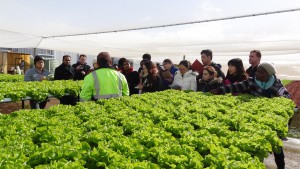Our students enrolled in Global Food and Agricultural Markets shared their views of the role of youth in agriculture.
By Huayuan Cai, Pham Thi Thuy, James Githua Muhia and Junjie Zhang
Youth in Australian Agriculture
Agriculture is an important industry for Australia. Products coming from the livestock sector, for example, have been exported to different parts of the world making agricultural sectors as one of the most essential power to drive economic growth. However, some researchers indicate that the average age of farmer in Australia is too high, over 50 years old in 2010. In addition the number of farmers in Australia has been declining from 260,000 in 1975 to 136,000 in 2009 (Millar & Roots 2012, p. 30). This demonstrates the need to integrate youth in the Australia agricultural industry.

Master of Global Food and Agricultural Business students during their field visit
There has been a systemic and universal stereotype that
Farming is both physically demanding in terms of energy input and unprofitable which have factored in creating youth disinterest in agriculture.
However, inventions and development of new production technologies has radically changed the agricultural landscape which has made agriculture profitable by making operations easier and increasing output .
In fact, agriculture has transformed into a science requiring a high degree of skills to execute and manage.
Introducing young people to this modern agricultural realities will strongly influence young people’s ‘renaissance’ in agriculture.
Youth should be encouraged to be agricultural entrepreneurs through formal and and informal training. Both print and electronic media should upscale programs targeting young people. Young agricultural workers should have the capacity to give detailed agribusiness analysis such as enterprise gross margins, value chains and marketing. These areas are as important as technical aspects of agriculture. Education to influence young people to change their deep-seated attitudes to agriculture is therefore crucial.
Modern day techno-savvy youth will readily embrace agricultural innovations and technology and utilise it to make money. An example of such a technology is the RFID technology which is a radio frequency identification system commonly used in livestock to track and identified the animals (Farm industry news, 2011). Furthermore, biotechnology and new machines application in agriculture change the way of traditional agriculture. It shows potential of agricultural employment as a high educated profitable job.
Examples from Agriculture in Japan and Taiwan
The Japanese agriculture sector provides a good example of engaging young people in agriculture. Sharing the ideas with experienced farmers and government extension service staff have assisted young agricultural workers in improving their technical and marketing skills, land management, etc. These young workers then become independent and even help other youths. As a result, some of them had a gross profit, which increased by over 200%, of nearly 8.9 million yen on average.
In Taiwan, a ‘Youth in Agriculture’ program was designed to include over 250 young farmers under 45 years old. All of the young farmers who joined this program were taught extension skills. The government also supported them providing low-interest-rate loans to buy inputs as well as facilities.
What’s next?
Limited opportunities in the formal sector has seen an increase in youth interest in agricultural enterprises. Young people hold the promise to feed the growing global population. To achieve this, youth need to be provided access to education in agricultural technologies, linked to credit facilities, given access to land and other property rights and linked to market oriented value chains. Unfortunately, youth have been denied these opportunities due to traditional community land ownership systems and weak unfocused policies (Hartley, 2014).
In much of Africa, for example, land is owned by parents who in most cases do not hand over their land rights to their children.
There is a need for urgent policy change in developing countries to embrace affirmative action in young people in agriculture. This should focus in making agriculture attractive to young people and creating opportunities to improve their skills and access to technology and capital. These efforts will help curb the migration of youth to urban areas and therefore significantly reduce unemployment and poverty among young families.
References
Hartley, S. (2014). Collective Learning In Youth‐Focused Co‐Operatives In Lesotho And Uganda. Journal of International Development, 26(5), 713-730.
Millar, J, Roots, J 2012, ‘Changes in Australia agriculture and land use: implications for future food security’, International Journal of Agricultural Sustainability, vol.10, no. 1, pp.25-39.
*This article does not necessarily represent the views of Global Food Studies, University of Adelaide.

